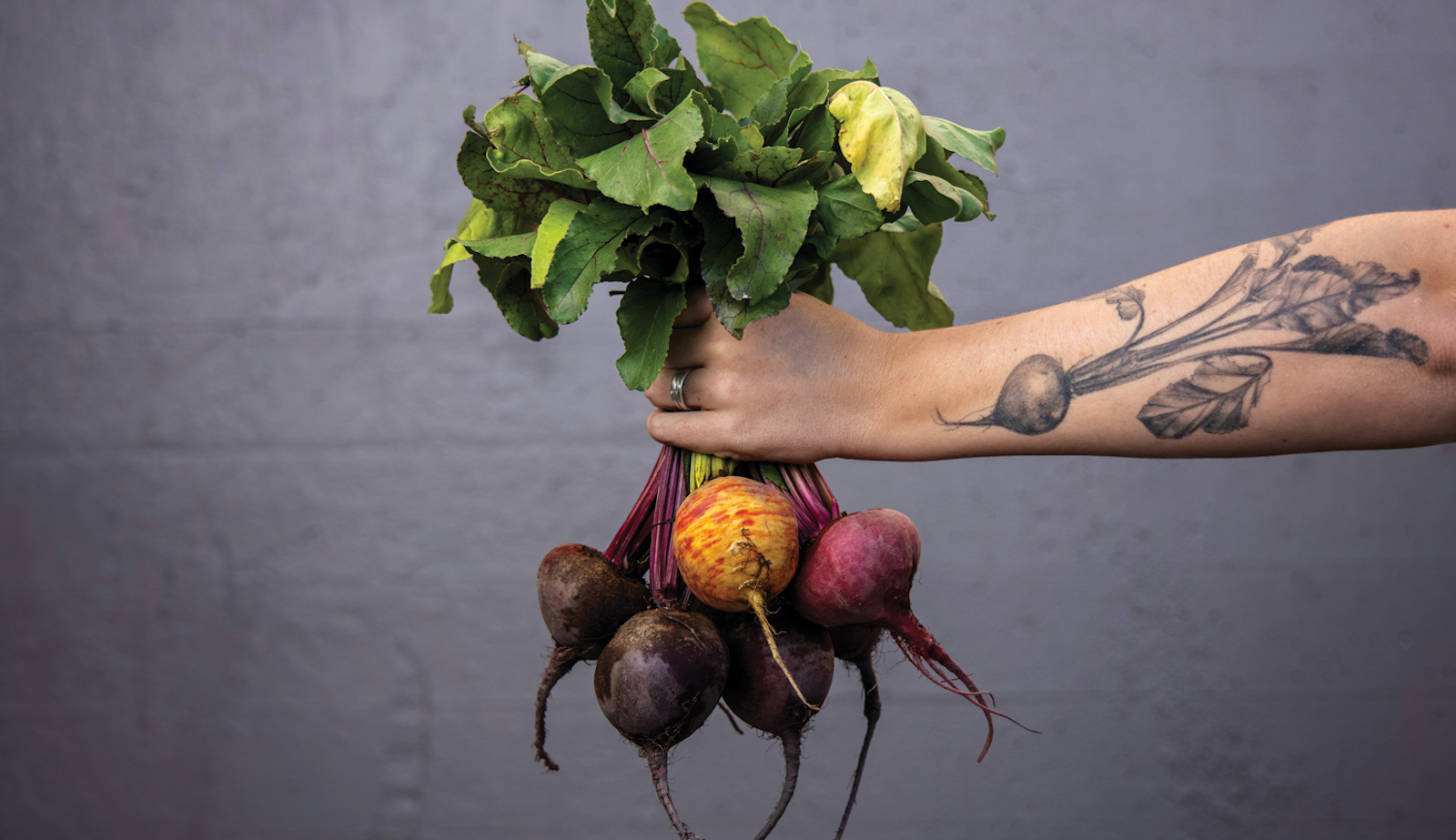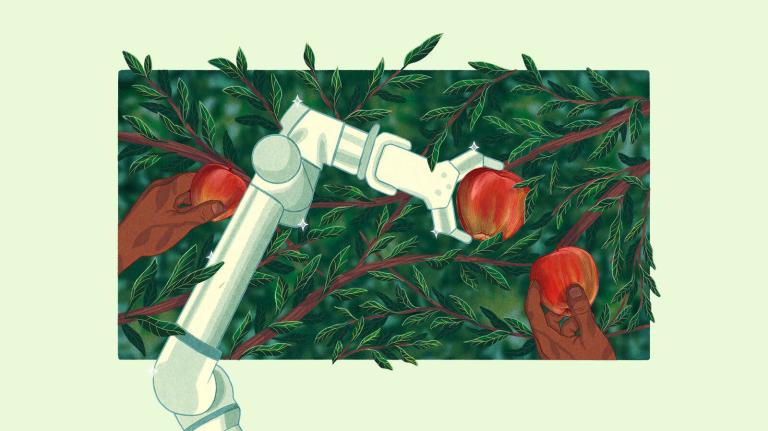This story was originally published by High Country News and is reproduced here as part of the Climate Desk collaboration.
Just over a year ago, on a brisk late September day in Spokane, Washington, two medium-sized cargo trucks backed up to the open garage door of a small warehouse in an alley behind a carpet store and a used-car dealer. Inside the warehouse, a forklift beeped incessantly as its operator stacked pallets of cardboard boxes full of meat, cheese, and produce onto the trucks’ lowered loading gates.
A farmer drove up in a faded red minivan. He unloaded bags and boxes of crisp red, orange, and yellow bell peppers and tomatoes as big as softballs, the last in a procession of morning deliveries from farmers to the warehouse of the Local Inland Northwest Cooperative, or LINC Foods. The co-op is a marketplace, an online and physical hub where restaurants, schools, grocery stores, hospitals, and individual shoppers can order produce and other food from small farmers in the region instead of relying on huge wholesalers.
Beth Robinette, one of LINC’s co-founders, checked to make sure orders were complete. Then the trucks pulled out of the alley. One headed south toward the college towns of Moscow, Idaho, and Pullman, Washington. The other went east, to restaurants and health food stores in Coeur d’Alene and Post Falls, Idaho, before returning to Spokane to zigzag between businesses and schools.
The smooth operation that morning was a far cry from LINC’s early days. In the summer of 2014, when the co-op was just getting started, Robinette and LINC co-founder Joel Williamson didn’t have their own warehouse. Instead, the two received produce in an alley behind a downtown motel. They’d wait next to a dumpster, “hoping for someone to throw us some carrots out of the back of their car so we could heap them into the back of Joel’s Scion,” Robinette said. Today, the co-op has nine employees and sells food from about 50 producers.
LINC is part of a growing nationwide network of local food companies that work with small farmers to help them reach bigger markets. These so-called food hubs allow producers to spend less time marketing and selling at venues like farmers markets and more time growing the food itself. LINC is unusual in that, unlike most food hubs, it is cooperatively owned by the workers who run it and the farmers who grow the produce it sells.
Food hubs like LINC serve as a breakwater against the rising tide that has been threatening — and often drowning — local farmers for five decades. That tide is powered by several factors: food industry consolidation driven by international trade policies, lax enforcement of monopoly protections, and federal subsidies that favor big farms at the expense of small growers.
Early this year, before the coronavirus pandemic began, LINC was growing steadily. It was able to offer locally grown fresh food year-round, including dairy and meat products, wheat and barley, and vegetables such as beets and purple potatoes, making the co-op a feasible alternative to supermarkets and industrial food suppliers. Then, in a single week in March, LINC, like so many other businesses, was abruptly and completely upended. Robinette and Williamson and their growing team faced the greatest challenge yet to the idea that a small co-op can help remake the food system of an entire region.
Twenty minutes west of Spokane, in the Channelled Scablands — a sculpted landscape of basalt buttes and winding troughs carved by massive floods during the last ice age — is the Lazy R Ranch, the family spread that Robinette and her father, Maurice, run together. The term “scablands” does not evoke an environment hospitable to farming, but this unique region is dotted with islands of loess, a windblown silt that makes up some of the most fertile soil in the world. On the hills of loess, farmers plow extensive golden wheat fields; in the channels, where there’s less topsoil, ranchers run cattle. The Lazy R, which stretches over 800 acres of gently rolling hills, low-lying ponds, and rock outcroppings ringed by ponderosa pines, lies in such a channel. The Robinettes raise cattle and a small flock of sheep; Beth Robinette lives in a house overlooking a pond full of cattails, while her parents live down a gravel road on another section of the ranch.
Between LINC and the Lazy R, Robinette stays busy. She is an affable woman, self-effacing and quick-witted, with a subtle gravity that draws people toward her. Her tapestry of tattoos speaks to her relationship with food — one side of her forearm is inked with the silhouette of a cow divided into butcher cuts, the other with an intricately drawn beet. The morning I accompanied her to the co-op’s warehouse, she had already squeezed in a handful of ranch chores, reporter in tow: She’d fixed a switch in her parents’ well, rounded up a few escaped cows, mended a section of fence, and moved her sheep to new grass with the aid of her overzealous border collie, Tom.
In the mid-1990s, when Robinette was in elementary school, Maurice Robinette began practicing a grazing strategy called holistic management. The idea is to mimic the natural relationship between migratory herds of grass-chewing animals like bison and the food they rely on. Instead of letting their cattle roam the entire ranch, the Robinettes move the animals to a different small pasture every few days, giving the grass behind them a chance to regrow. Since then, the Robinettes have seen healthier soil and more grass in their pastures. Those changes, plus others that have allowed them to sell beef directly to consumers rather than sending their cattle to industrial feedlots and meat processors, first steadied and then expanded the family’s profits.
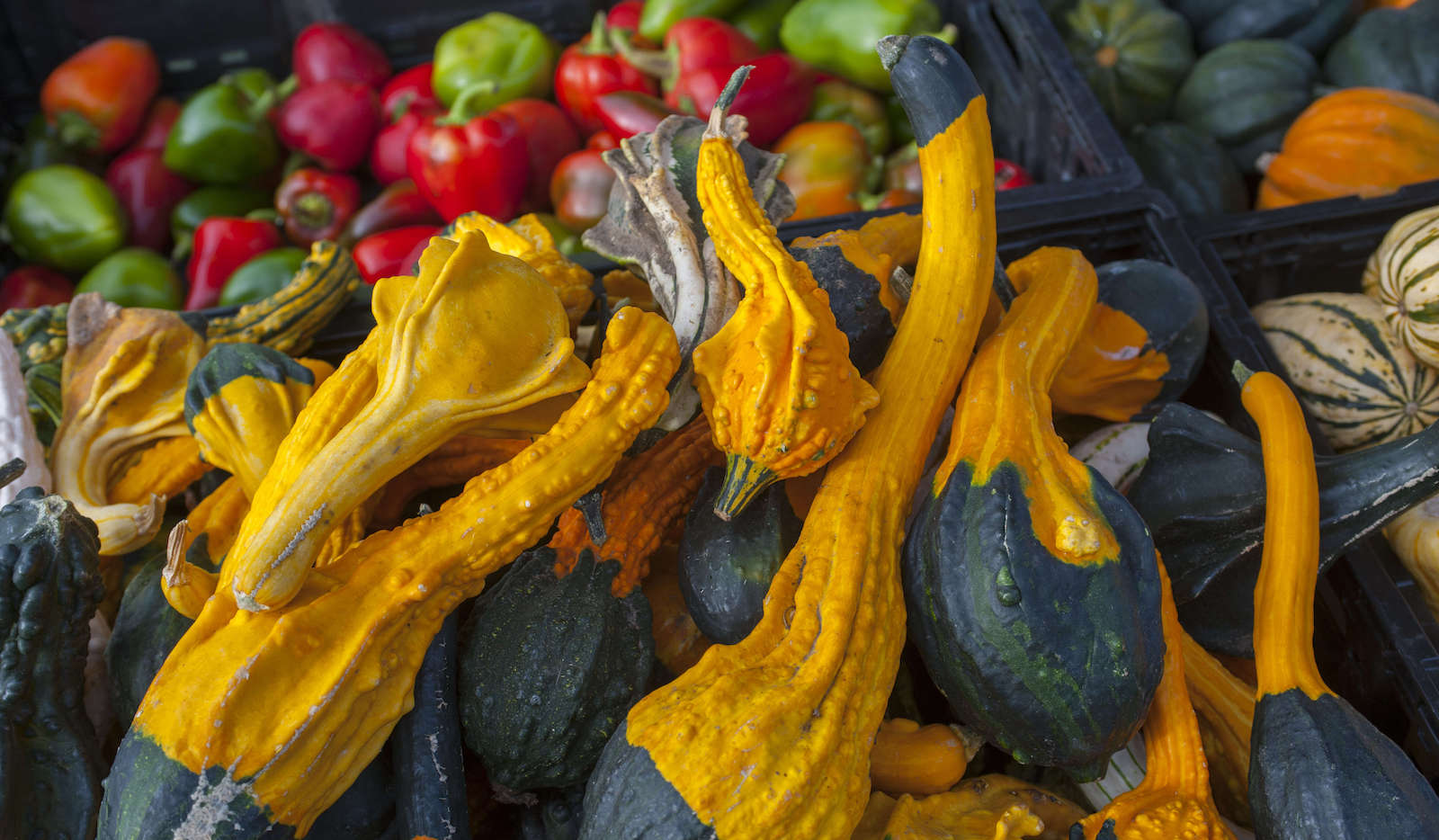
Pumpkins and squash for sale at a farmers market in Eastern Washington. Wolfgang Kaehler / LightRocket via Getty Images
LINC’s co-founder, Joel Williamson, also grew up in an agricultural family. But around the same time the Robinettes switched to holistic management, Williamson’s grandfather and father were closing their own business, a nearly 80-year-old flower-growing operation. “I was 16, it was 1998, the family business was failing, my parents got divorced,” Williamson told me. “It was like this idyllic childhood just crashing down.” What was once the family farm is now rows of aluminum mini-storage units.
We were sitting on bar stools in a corner of the Grain Shed, another cooperative that Williamson co-founded with a group of bakers, growers, and brewers who are reviving ancient grains and crafting obscure beers. (Like most small producers, including many of LINC’s farmers, Robinette and Williamson work multiple hustles to make ends meet.) It was February, a few weeks before the pandemic precluded such get-togethers, and a crowd buzzed around us. Williamson told me about how, when the family’s flower business closed, his grandfather chalked it up to foreign competition and higher operating costs brought on by federal policy. “They couldn’t have done a better job if they’d planned to destroy an industry,” he told the Spokane Spokesman-Review at the time. “Our government doesn’t give a darn is what it amounts to.”
The consolidation of American agriculture and the loss of economically viable small farms began in the wake of World War II. Nitrogen left over from bomb-making was put to use as fertilizer on increasingly mechanized, large, single-crop farms. Advances in agricultural equipment meant bigger, more expensive machines operated over increasingly vast tracts of land, and Cold War fears of nuclear disaster made producing shelf-stable food a priority. Federal farm investments focused on staples like corn, wheat, soy, and rice that could be grown on a massive scale.
During the last two-and-a-half decades, lawmakers poured hundreds of billions of federal dollars into large-scale farming of these crops; meanwhile, small, diversified farms were left with the dregs. Commodity payments — subsidies designed to keep farms in business and produce a steady supply of staple crops — make up the majority of taxpayer-funded agriculture aid. Between 1995 and 2019, nearly 80 percent of those payments went to the top 10 percent largest farms in the country, according to U.S. Department of Agriculture data compiled by the Environmental Working Group, a nonprofit dedicated to environmental health.
In the late 20th century, the rise of neoliberal economic policies increased competition among farmers. International trade pacts like the North American Free Trade Agreement removed tariffs and helped give rise to a truly worldwide agricultural system — pitting producers in places like Spokane against those in countries that offered both cheaper labor and better growing conditions for certain crops, such as tomatoes and flowers.
Up until a couple generations ago, Spokane was the focal point of the regional food system. Before the area was colonized and Northwest rivers dammed, the waterfall at the center of what is now downtown was an important location for tribal nations to gather and harvest salmon. Later, the city became a commercial hub. From the 1910s to the 1960s, independent vendors sold local produce at the Washington Market, a two-story brick building with awnings that stretched over the street on warm summer days. But as the city suburbanized and large distributors and chains claimed a bigger share of the market, communal downtown venues disappeared; the Washington Market became a specialty food store shortly before it burned down in 1978. Though LINC’s transactions take place on an online cloud, its purpose is very similar to those brick-and-mortar produce markets. “It’s a new way of doing a really old thing,” Robinette said.
That day in The Grain Shed, the smell of bread toasting in the residual heat of the previous night’s fire filling the café, Williamson talked about the history of the building, located in Spokane’s newly hip South Perry District. Decades before he and his business partners renovated it in 2018, the café was a corner store, where a local courier would pop in with fresh flowers from Williamson’s family’s greenhouse. Now, that kind of market is a rare find. “As stores became chains and those chains started to buy in larger quantities … all of a sudden it’s cheaper to buy from thousands of miles away than here,” he told me, maintaining eye contact so intense that it drowned out the many distractions of the loud café. “That was kind of the downfall of our industry.”
The consolidation of the agricultural system has made food cheaper and corporations richer. It’s also driven family farms out of business. In the 1950s, the United States had nearly 3 million farms smaller than 50 acres; now, there are fewer than 900,000. Today, the majority of U.S. cropland is on farms larger than 2,000 acres, and many of the remaining small farms produce little in food or sales. At a dairy expo in Wisconsin last year, Sonny Perdue, the secretary of agriculture, put it bluntly: “In America, the big get bigger and the small go out,” he said. An editorial in the Minneapolis Star Tribune called his speech “Darwinian thinking at its most brutal, with small, struggling farmers selected for extinction by a system that sees no place for them.”
Most of the farms in the LINC cooperative are just a few acres in size and run entirely by family members. Larger commercial farms, especially those that grow fruit and vegetables that have to be hand-picked, depend on seasonal workers. The labor of migrant and immigrant farmworkers, most of them from Mexico, underwrites the growing wealth and power of big agriculture in the United States.
About half of those workers lack legal immigration status, according to U.S. Department of Labor data. (Other sources estimate the real number may be as high as 70 percent.) That leaves them with limited power to stand up to abuses in one of the deadliest industries in the United States — one that became even deadlier after COVID-19 outbreaks hit food processing plants and slaughterhouses starting this spring. As summer rounded into fall and wildfire smoke blotted out the sun, farmworkers in eastern Washington continued to labor with no employer-provided protection from the hazardous air. “My employer cares less about its employees than it does about making sure that we are working, whether we feel sick or not,” said “Mr. Gonzalez,” a farmworker who used a pseudonym in a September interview with The Counter, a nonprofit newsroom that investigates the food system.
Despite the disadvantages laborers face, collective action led by Latino and Indigenous workers has helped improve conditions and pay in Washington’s farming industry. In 2018, seasonal workers with H2-A visas walked off the job and filed labor complaints, leading to some payouts and a court settlement in favor of the laborers. And this year, in response to the hazards of COVID-19, a string of wildcat strikes in the Yakima Valley helped apple packinghouse workers secure better pay and working conditions.
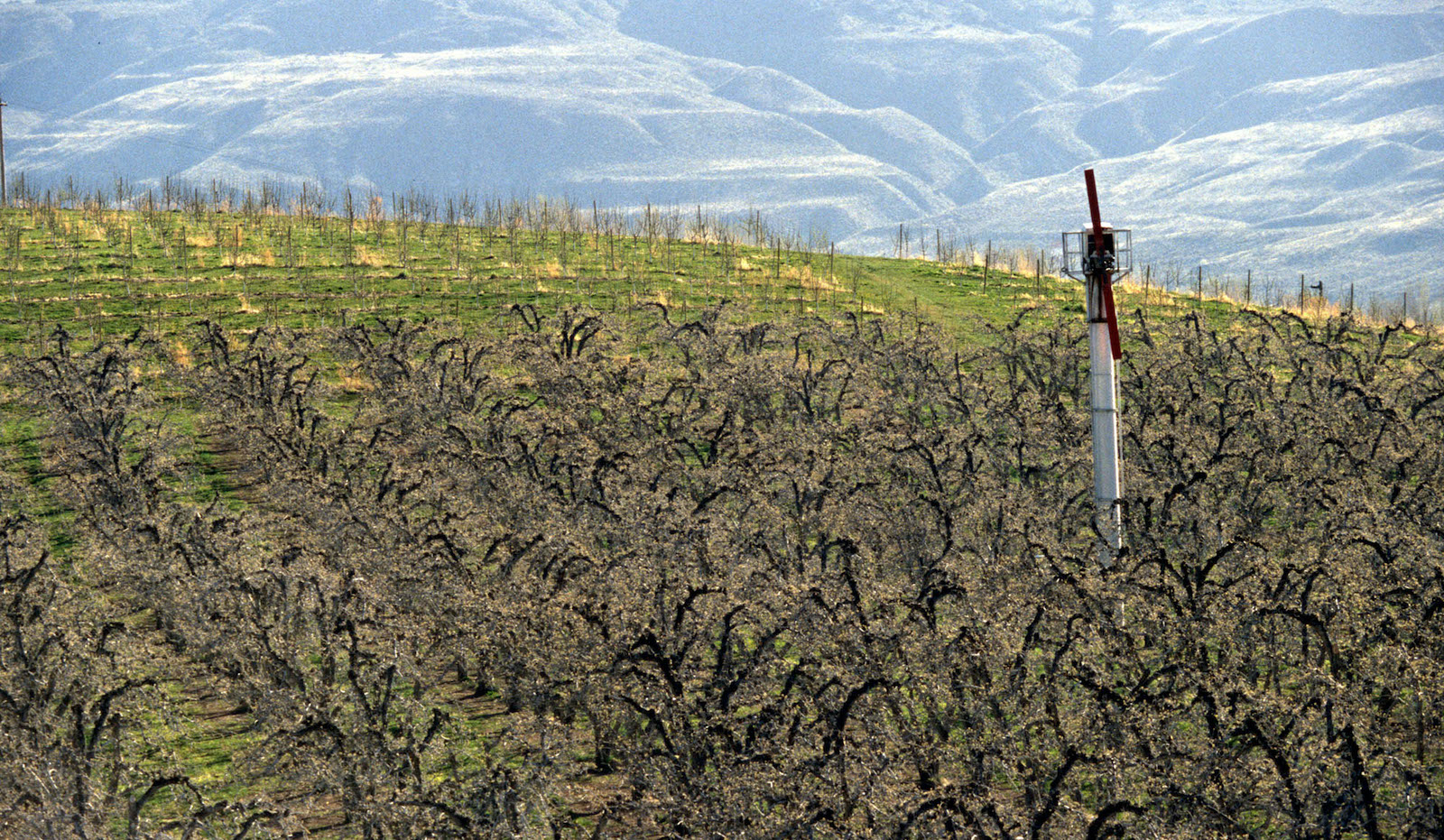
An apple orchard in Eastern Washington. Tim Matsui / Liaison via Getty Images
Industrial farming also exploits the environment, which is unable to collectively bargain for a better deal. Agriculture is responsible for one-tenth of the United States’ greenhouse gas emissions, and agricultural runoff is the main source of pollution in the nation’s unhealthy rivers and lakes. LINC’s member farms distinguish it from industrial agriculture: Only a handful of the co-op’s larger farms are big enough to employ anyone beyond the owners’ families, and those few have educational on-farm internships and hire seasonal labor at minimum wage. Furthermore, because of the modest size of LINC’s farms, most are worked by hand or small machines rather than massive tractors, which helps reduce runoff and boost soil productivity.
LINC’s producers are organized into several guilds — grain growers, fruit and vegetable farmers, livestock and dairy ranchers, and processed-food makers — that meet annually to share knowledge and compare best practices. Together, they agree on the co-op’s standards, such as the proper conditions for keeping animals or how pesticides can be used. The fruit and vegetable guild, for example, has banned synthetic pesticides entirely. New producers can join with the approval of LINC’s board, a membership fee, and a pledge to uphold the growing practices of the co-op.
Last winter, LINC outgrew its downtown warehouse and moved into a new one, in an industrial park just east of Spokane. When I met Robinette there in February, she greeted me like an old friend, with a warm hug. Big rigs and smaller delivery trucks were lined up in rows alongside nearby warehouses and railroad tracks; inside the building, food-safety manuals lined the walls, and whiteboards were cluttered with meeting notes. Back outside after a quick tour, Robinette checked that the roll-down door on a sparsely loaded delivery truck was secured, then we both climbed into the cab.
Gravel-speckled slush melted in the median as we joined cars and trucks humming along Interstate 90 under low gray clouds. Our first stop was a food-processing business housed in an old red farm building, where Robinette traded a cardboard box filled with heads of cabbage for huge bags of shredded cabbage bound for local restaurants. Next, we visited a strip mall in Post Falls, Idaho, where Robinette picked up a few cases of kombucha. Then we were off to Coeur d’Alene, Idaho, to deliver a couple of boxes filled with beets, cheese, and cuts of pork through the back-alley basement door of an upscale restaurant.
In the truck, Robinette reflected on the rapid expansion of the co-op, and its growing pains. In the six years since it opened, LINC has nearly doubled its business every year: It started with around $30,000 in sales in 2014, and is poised to bring in about a million dollars in 2020.
Despite that growth, the co-op generally operates at a loss. Distributing food the way LINC does requires a lot of labor and capital. To stay in business, it depends on federal grants, loans, and wealthy investors who have pumped hundreds of thousands of dollars into the company in return for a share of future profits — making investments that, Robinette acknowledged, are motivated more by philosophical than financial considerations, from backers who are less interested in a future windfall than in seeing LINC and its local farmers succeed.
LINC and its investors want the co-op to help expand the local food economy. Its online marketplace functions much like the physical produce markets in downtown Spokane used to, albeit with a digital twist: Farmers submit lists and set the prices of available produce each week, and LINC uploads them to its online marketplace. Next, chefs and cafeteria managers scroll through and make their selections — spicy radishes and tender microgreens in the spring, or juicy tomatoes and crisp apples in early fall.
Farmers benefit because they can access a large market without having to maintain business relationships with individual restaurants, deliver to multiple locations or staff a farmers market booth. For buyers, the co-op offers the convenience of a one-stop shop: They can place bigger orders than a single small farm could fill, and purchase a wide variety of local produce in one place.
LINC has been a boon for Gonzaga University, a private Jesuit school in downtown Spokane. Around the same time the co-op was founded, Gonzaga publicly pledged to source at least 20 percent of its food from what it described as “ecologically sound, fair and humane, and local and community-based providers,” by 2020. Last year, produce from LINC accounted for more than a quarter of that 20 percent, and Gonzaga reached its food sustainability goal a year early.
Jim Simon, who leads Gonzaga’s campus sustainability efforts, has seen the benefits of LINC both in his work and on his breakfast plate. “I eat a lot of eggs, and you can see and taste the difference,” Simon said of the eggs he buys from the co-op, which also sells a weekly food box. “It gives you pause when you think about it. Why am I buying a higher volume at the store when I can get better quality from local farmers?”
As LINC expands the market for local producers, the co-op’s employees and founders are asking themselves how to make their food available to more people. LINC’s products are expensive. Robinette doesn’t harbor any illusions about what that means. “In general, our customer is a more affluent person who is searching out local food,” she said. Access is often a matter of wealth or privilege, whether that comes from the ability to pay for Gonzaga’s $46,000-plus annual tuition or a $20 meal at a restaurant.
This system, in which fresh local food has become a luxury, stems directly from a food economy structured around producing cheap food by undervaluing labor and externalizing and subsidizing the true costs of production. Small-scale organic farming and paying farmworkers a living wage are far more expensive ways to produce food, said Ellie Bomstein, a project manager at the Wallace Center, a nonprofit that provides technical support for food hubs, including LINC. Creating a workable small farm economy and promoting access to healthier fresh foods would require “a big shift in what we subsidize and value,” Bomstein told me.
And enacting that shift would take a monumental effort. Though LINC has grown, it still accounts for only a tiny fraction of Spokane’s food economy: The city’s institutions and restaurants spend about $2 million on food per day, twice what LINC sells in a year. That’s a huge gap that could only be closed by making serious changes to the structure of agriculture, both locally and nationally. As long as federal spending prioritizes large-scale farming of staple crops and refuses to regulate corporate monopolies, the overall model won’t change.
Building an alternative to the transnational corporate food system may seem like an overly ambitious project popularized by a generation of idealistic young people. But LINC’s founders are clear-headed about the limits of their project, and they aren’t particularly rosy about their ability to affect the kind of structural changes necessary to make the local food system more robust.
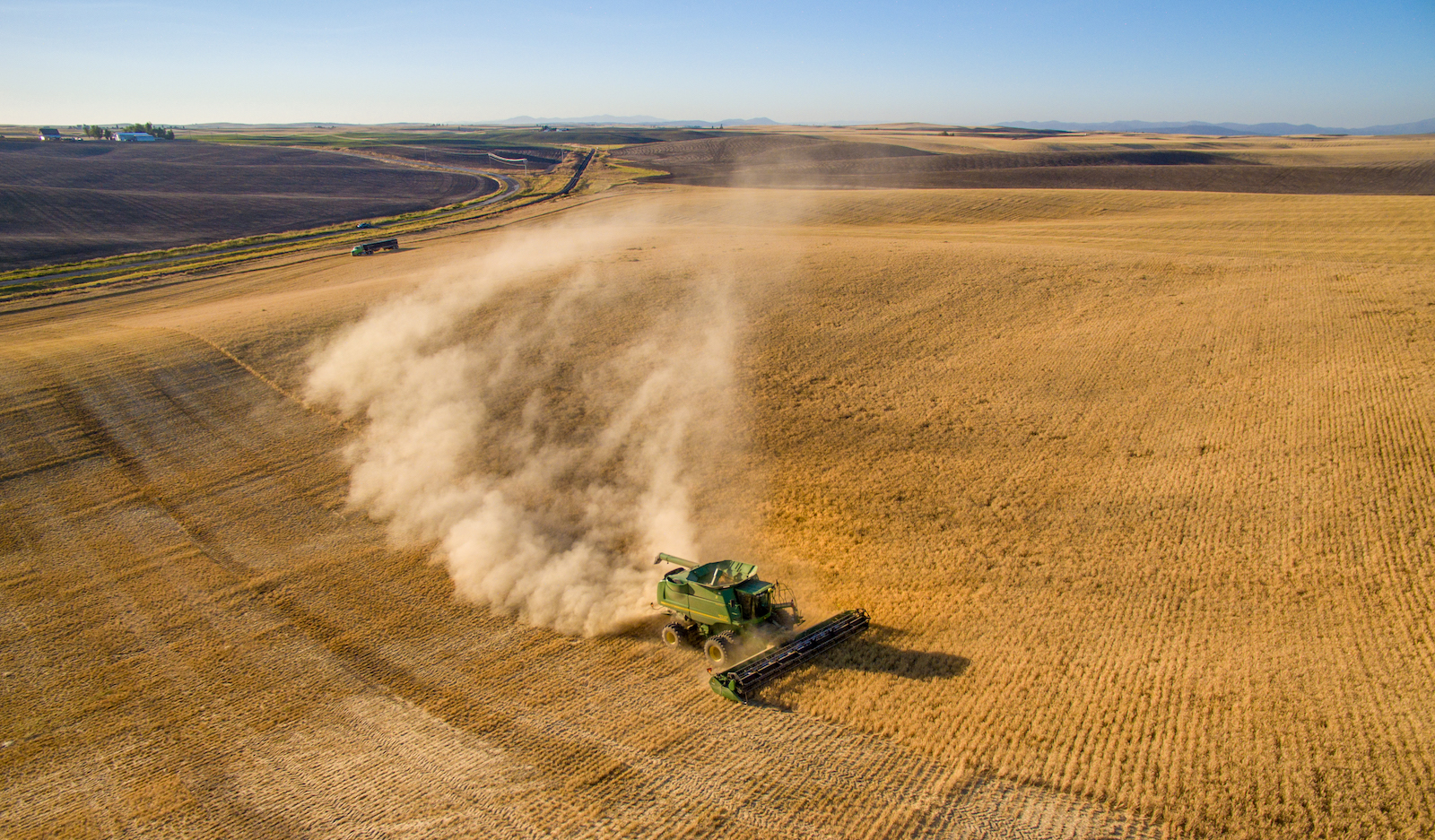
Barley harvest in Eastern Washington. VW Pics / Universal Images Group via Getty Images
Robinette, in particular, takes a pessimistic view. She thinks the global agriculture system is already broken — beyond the point of repair, in some ways — citing examples like the climate crisis, habitat destruction, and the high suicide rate among farmers. Still, she is motivated by the slight counterbalance LINC provides to the system, simply by producing food in a more ecologically sound way and allowing her to mentor other growers to do the same. “I’ve always felt like this was something to do in case the world doesn’t end,” Robinette said.
That mindset relieves some of the pressure of her ambitions for LINC. Instead of taking on every messed-up aspect of the global food system, Robinette, Williamson, and the other co-op members are doing what they can to make the situation in Spokane better. That way, Robinette said, even if LINC fails, some scaffolding will already be in place. Farmers will still have the peer networks that LINC built; buyers will still know which farmers are producing the food they want; eaters will still remember that the plumpest blueberries they had all year came from a local farm in summer.
In the meantime, LINC has found ways to bring food and knowledge about local agriculture to people in the community. State-funded fresh food programs have paid for outreach to local schools, where kids learn how to shuck ears of corn and what carrots look like when they still have their green leafy tops, before they’ve been shaved down to carrot sticks. And the co-op shares any excess produce it has with local food security initiatives, such as the Catholic Charities Food for All Program. “They’re always looking out for us,” said Jesse Hansen, the program’s co-coordinator.
“We feel like all we can do is do our part,” Williamson told me. Once people and land aren’t seen as separate, but instead as essential and intertwined, a more resilient food system will begin to take root in the Inland Northwest. “You just hope that someday, if everything else is failing, we will have built this system here that’s more self-sustaining, and more just, and a little more sustainable for the environment,” he said.
As the COVID-19 pandemic spread across the United States in early 2020, cogs in the industrial food system faltered. Slaughterhouses and meatpacking plants became sources of major coronavirus outbreaks. Farmers who rely on selling their food to schools and restaurants were left without buyers as shelter-in-place orders went into effect. Some plowed under ready-to-harvest crops or left piles of squash to rot in their fields, swirling with flies. Around the country, millions of animals were killed en masse. With empty shelves in grocery stores and supermarkets imposing buying quotas, LINC saw a void it could help fill.
First, though, the co-op had to deal with the pandemic’s immediate consequences. When Washington’s statewide stay-at-home order went into effect in late March, LINC lost 80 percent of its business in one week as practically all of its wholesale customers shut down or began operating at a fraction of their normal capacity. “It was an ‘oh shit’ moment,” Robinette said. The company’s staff met via conference call to discuss their options. Some advocated for a temporary shutdown, while others wanted to figure out how to stay open and keep getting local food on people’s plates.
They decided to adapt. But when they ran the numbers, they realized they couldn’t afford to keep the full staff working. Three of the co-op’s nine workers were furloughed; Robinette cried as she shared the news with them via conference call. “It was so impersonal,” she said. “And it’s not because they’re shitty at their jobs; they’re great. We just couldn’t make payroll.”
Remaining staff pivoted from focusing on sales to institutions to sales to individual shoppers. Within a week, they had created a direct-to-consumer online marketplace to augment their waning wholesale market. Robinette and the workers took turns working self-isolated shifts at the warehouse, breaking down hulking 50-pound bags of potatoes destined for cafeterias into 5-pound bags for stuck-at-home cooks.
The disastrous March put the company in a $50,000 hole. Dan Jackson, a vegetable farmer and LINC’s sales director, took to the local TV news to pitch the new online shop. “We still have farms in our region who have food available,” Jackson said. “I think at these times, it’s not only ‘support your neighbors’ and ‘support your businesses,’ (but also) ‘support your farmers.’”
His plea seemed to work. Reduced labor costs, higher price margins from direct sales, and the increased necessity of cooking at home meant that, “weirdly, we landed in a really good spot,” Robinette said. Even as items like eggs, meat, and flour were being rationed at local grocery stores, LINC had a steady supply. In April, the co-op turned a $20,000 profit. By May, with the help of a loan from the federal Paycheck Protection Program, LINC was able to rehire its full staff.
But they knew that their new customers couldn’t absorb the coming deluge of summer produce. It’s a lot easier and more reliable to sell a pallet of food to one restaurant, or a couple pallets to a cafeteria, than it is to market that same food to individuals used to shopping at grocery stores. With uncertainty over who would buy the summer’s bounty looming over her, Robinette attended what seemed like an endless stream of conference calls with other food hubs around the state and region. Everyone had the same question: How could they find buyers for their farmers’ food?
One of the topics they discussed was a USDA pandemic response initiative: The Farmers to Families Food Box Program, announced in April, which pays food companies to distribute produce, meat, and dairy to local food banks. At a time when the co-op staff was already stretched thin troubleshooting its newly launched direct-to-consumer marketplace, they spent long nights writing up their bid for a contract. “It was a huge push,” Robinette said. “I haven’t pulled an all-nighter since college.”
The effort paid off, and LINC won a contract to deliver hundreds of boxes of fresh food per week to three regional food banks. Between mid-May and September, it delivered nearly 8,000 boxes filled with fresh vegetables, fruit, and local milk.
In Tekoa, Washington, a small farm town with a population of less than 1,000 nestled in the rolling wheat fields of the Palouse region, fresh and free food from LINC was a crucial resource as the pandemic wore on. The town has just a single small grocery store, and it lost one of its two restaurants during the COVID-19 crisis. In March, there were about 45 households using the local food pantry, said Connie Marsh, who coordinates with the Council on Aging to distribute food in Tekoa. That number had doubled by August. “Their produce was absolutely vital,” Marsh said.
With the aid of the USDA program, LINC was succeeding in more ways than one: Not only was the co-op able to sell all of its farmers’ produce during an unprecedented upheaval to the food system, it was also serving a larger and less affluent community at a time when the need was especially urgent. At the end of June, the USDA extended LINC’s contract through August. And individual sales were expanding, too. Subscriptions for LINC’s weekly food box, a reusable cardboard carton filled with in-season vegetables and fruits — peas in early summer, pears by fall — were up by 240 percent. The co-op was on pace to sell the most it ever has in a year. “It feels like we’re tapping into a new way of doing things,” Robinette said.
Then, in July, the USDA announced that distributors would have to submit a new bid if they wanted to continue participating in the food box program. The agency also tightened up the process, adding new requirements; in the initial, rushed rollout, companies with little experience or capacity had ended up winning contracts they couldn’t fulfill. Suddenly, LINC’s ability to continue stocking community food banks during the pandemic was in doubt.
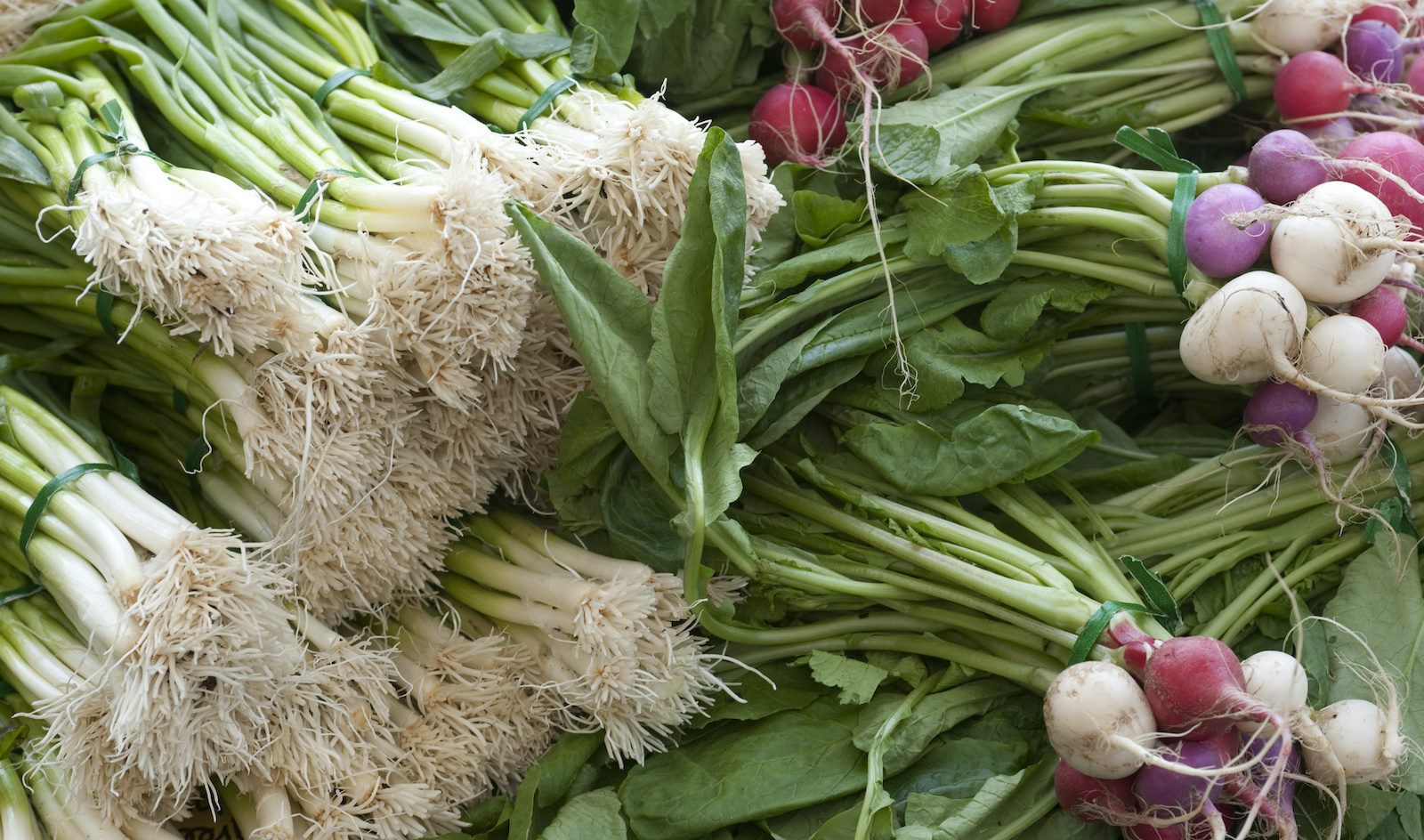
Produce for sale at a Washington farmer’s market. Wolfgang Kaehler / LightRocket via Getty Images
Meanwhile, the pandemic itself was worsening. COVID-19 cases reached a second and higher peak in July and early August in eastern Washington and North Idaho. It felt like LINC was facing a repeat of the spring, but the season made the situation even more dire: It wasn’t the local food doldrums of March, when fields were just thawing out and there was nothing to sell but stored crops, dry goods, meat, and dairy products. Instead, it was late summer, the most bountiful time of year for fresh produce in the Inland Northwest. Crunchy cucumbers, sweet melons, and spicy jalapeños were ready to harvest. Without sales to schools or through the USDA program, it was “heart-wrenching to think about what could happen for farmers,” Robinette said. “We’d be turning away thousands and thousands of pounds of produce.”
But the relationships that LINC had built among workers, community members, and other food organizations proved crucial. The co-op is no longer a drive-by, carrot-toss-in-an-alley operation. Food bank managers reached out to LINC to strategize about how to fulfill the more demanding USDA program requirements and keep their shelves full. The Inland Northwest Farmers Market Association offered to partner with LINC: It would help with the USDA paperwork and food distribution and, in return, tap into the co-op’s producer network. “It’s the best of both worlds,” Robinette said. “We can create a much stronger program than either of us were running separately.”
With the clock ticking on the bid deadline, LINC and its new partner got to work. Under the hot August sun, Robinette propped her phone on fence posts at the Lazy R Ranch as she discussed the contract proposal’s details over a series of video conference calls. She worked from post to post, stringing barbed wire and pulling it tight with a heavy metal tensioner, building new paddocks for her cattle to graze so the grass could regrow. A few weeks later, the USDA announced that LINC didn’t win the contract. Robinette, downtrodden, told me that a lifetime in agriculture had prepared her for disappointment. All she could do was press on.
Then, in early October, a new solution emerged: Spokane County awarded the joint venture half a million dollars to continue supplying local food programs. The bonds LINC had fostered in the community held as firm as a newly strung fence, made strong by a thousand small actions, like ratcheting a tensioner again and again.

